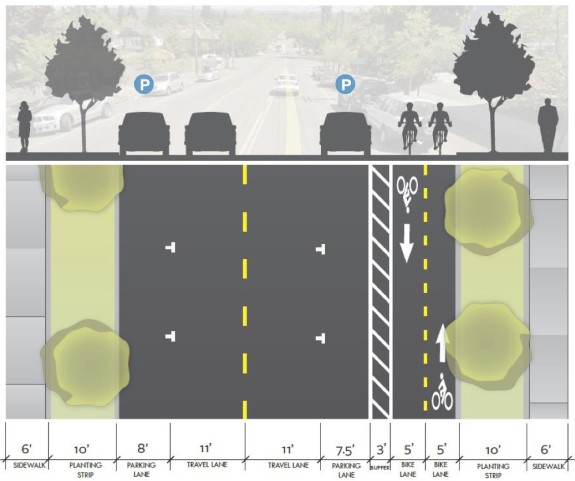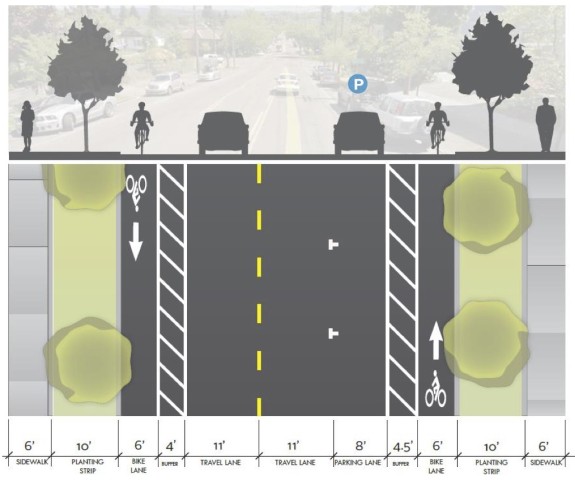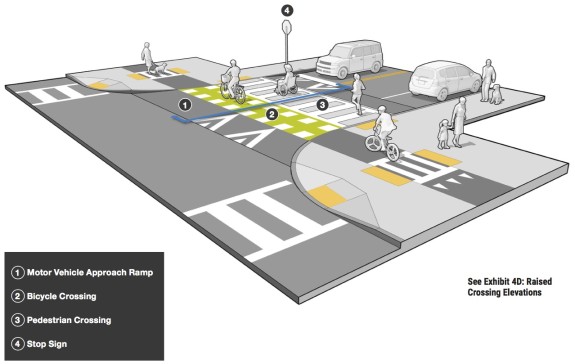
A truly rapid bus on Madison Street from Colman Dock to Madison Valley? Protected bike lanes on E Union Street? Major walking improvements at every terrible Madison intersection?
Now that Move Seattle has passed, all this is on track to actually happen. In fact, the Madison project was basically the Move Seattle poster child, and it goes through a part of town that voted heavily in favor of the levy.
The city has a mandate to knock this project out the park. And that means getting all the details right.
You can help by attending an open house from 5 – 7 p.m. Monday at the Central Library downtown (level 4, room 1). Presentation at 5:30. Seattle Transit Blog even created a Facebook event so you can invite your friends.
Speaking of Seattle Transit Blog, Zach Shaner wrote a great analysis of how the project is already starting to drift away from the center-running exclusive transit lane vision that won so many hearts and minds. As compromises add up, the “rapid” in bus rapid transit starts to lose out.
There’s a similar debate about the bike route elements of the project (see our previous story for more). Bike lanes on Madison itself are already pretty much off the table, with planner opting for a “parallel” bike route instead. That argument aside, the question now is whether the city will follow best practices for planned bike lanes on E Union Street from 12th to MLK. Do we do it right and build one-way bike lanes on both sides of the street, or do we compromise away safety and usability by building a two-way lane on the south side of the street?

 It’s going to take all of you getting active and making sure this project follows best practices. It will probably also need some innovation (for example, having street parking on the uphill bike lane side, but keeping views very clear for the downhill lanes). The E Union Street protected bike lane is noted in the Bike Master Plan as the major bike connection through this part of the Central District, and it’s a chance to show off how a bike lane done right can improve mobility in a neighborhood.
It’s going to take all of you getting active and making sure this project follows best practices. It will probably also need some innovation (for example, having street parking on the uphill bike lane side, but keeping views very clear for the downhill lanes). The E Union Street protected bike lane is noted in the Bike Master Plan as the major bike connection through this part of the Central District, and it’s a chance to show off how a bike lane done right can improve mobility in a neighborhood.
It’s also a chance to highlight how quality bike lanes can be part of major walking improvements that make streets safer for everyone. Crossing Union on foot can be a scary experience, even if you use one of the marked crosswalks. There are several ways to do this, including everything from including protected crosswalk islands between the bike lane and the street or raising the bike lane and sidewalks so people driving have to go over a bump before crossing.
Raising the bike lane to sidewalk level may also help slow people on bikes where people on foot cross paths.

If all goes according to schedule, the preferred design should be selected this fall and final design will happen in 2016 and 2017 with construction in 2018 and service starting in 2019. So now is the time to make sure we design this right.








Comments
21 responses to “Help keep Madison BRT and bike route designs bold at Monday open house”
[…] Figuring out how to run a parallel-ish bike route along Madison is another key issue for the project. In May, plans call for a protected bike lane along Union between 27th Ave and University, UPDATE: Seattle Bike Blog weighs in: […]
Union St is far too steep to have safe 2-way PBL. I think it is too steep for a downhill PBL too (take the lane going downhill, but I’m a fearless Fred curmudgeon
Just one complaint/concern to hopefully add to the discussion:
BRT is the wrong transit mode for this hillclimb. Frequent interval service rather than a reduced trip time makes more sense IMO. BRT suggests a 60′ articulated high-capacity bus, NOT a good idea on steep hills. Perhaps Metro BRAINS are thinking 60′ buses with limited stops to reduce driver cost? Reaching the waterfront, Western or Alaskan Way, makes sense, but, if this is the only east/west transit service from Coleman Dock, the demand for many stops downtown suggests a COMPLETE f’n redesign of extremely steep downtown stops. Think about it.
My Oregon sense as a travel/transport system designer here vs Elliott Bay is – SDOT retains more than a few leftover notions from chief Crunican years, 2001-2009. Crunican did NOT come with glowing recommendations. She left ODOT and Oregon after harsh critiques from ped/bike and transit advocacy groups, street design urbanists, developers. If she’s up to little good as Bay Area BART Gen Mgr, I wouldn’t be surprised. That said, the argument this site provided convinced me that the measure MOVE would pass. I credit the draft renderings posted and extensive analysis of street design proposals as trustworthy.
Plan B for Bertha, on record at Wsdot, if you haven’t obtained a copy and discussed it, Seattle is doomed. As planned, the full length bore will AMPLIFY destructive earthquake forces and accellerate gradual settling affect damages beyond repair. That’s Crunican for you. Just get yourself a fn copy of PLAN B and f’n read it and the rest of the f’n Seattle Circulator Plan
(still blacklisted in Seattle).
SDOT suggests six minute frequency all day. That is pretty frequent. I’m sure they know which machines can get up the hill and which ones can’t.
Oh, and reduced trip time makes frequent service all the more affordable. There will be plenty of stops, but with off board payment, there will be minimal dwell time (likely less than our light rail system). Signal priority will complete the deal, making sure the drivers spend very little time waiting (and more time moving people).
Speaking of the MassDOT guide, that 10-foot-wide sidepath is only safe for < 150 bikes per hour, and that's on level ground.
Narrow 2-way cycletracks are especially hazardous on slopes. Even Broadway gets steep enough that you have to ride your brakes to keep a bike under 15 mph, but its sight distances at driveways are barely adequate for 10 mph.
Let's not do that again.
Tom, I appreciate you taking this position: “Do we do it right and build one-way bike lanes on both sides of the street, or do we compromise away safety and usability by building a two-way lane on the south side of the street?” It’s an important point that I hope SDOT takes to heart when contemplating two-way lanes in the future.
In response to Gary Yngve, above (“I think it is too steep for a downhill PBL too”), as a fellow Fred curmudgeon, I share this concern and preference for taking the lane. However, I think the one-way PBLs would possibly be ok, but only if the parked cars buffer the slow-moving uphill riders and the downhill riders are separated only by a painted buffer, so they retain good visibility and sight lines. (The parking would have to switch sides at the top of the hill.)
If you build a one-way separated lane uphill, and don’t install one downhill, how many conflicts will you have with wrong-way riders coasting fast downhill in the uphill lane?
While personally I’ll take the safety of the street over the separation of a sidepath at those speeds, there are many people who don’t agree. We need to consider how they will use the street, too, even if that means recognizing that they’ll ride the wrong way in a one-way lane if they don’t have a lane going their direction.
Just to be clear, I’m suggesting it might be acceptable to have a parked car buffer uphill and a paint-only buffer downhill, just as depicted in the one-way-lanes rendering above (except there, it’s not clear which side is uphill). So the downhill lane is, in fact, also “separated,” but only by paint.
You seem to be objecting to this proposal based on the possibility that people will prefer to salmon downhill in the car-buffered uphill lane. To me, that seems unlikely to be a common occurrence. But assuming it is a significant problem, based on your consideration of “how they will use the street, too” what is your proposal to address this potential issue?
Josh, I find salmoners where there are bike lanes on both sides and they are just too lazy to cross the street. Yes, they are extremely dangerous. But I think the correct fix is to make it easier to cross the street to the right side. Specific areas that I have encountered salmoners going down the uphill side are Eastlake behind Fred Hutch and University Bridge. I’ll also see people slowly ride the wrong way on bike lanes on Phinney/Greenwood DZBLs, but at least there, it is flat.
Sorry, to be clear, I believe we should have both a downhill lane, suitably wide with a permeable buffer, and sharrows in the travel lane.
Some have suggested sharrows only downhill, since it’s steep enough that no PBL could be safe. I agree that a PBL would be hazardous at coasting speeds, but some people will salmon in a wrong-way PBL before they’ll ride in the street with sharrows. So, both.
Wow, “salmoners”. I love it. Learn a new word every day. But wait, wouldn’t salmoners only be going upstream?
Sorry, I know this stuff is very important, but still, what a great term.
A part of me hopes that if SDOT continues to let the BRT elements of the Madison project decay, eventually they just abandon the project and put in bike lanes and subtler transit priority elements instead. An all-Madison bus route from Colman Dock to Madison Valley looks good on a map, but misses light rail stations and, as has been discussed on STB multiple times, makes it much harder to make sensible routing decisions for buses on other corridors in Capitol Hill/the CD.
As someone who lives at 20th and Union, I am excited about the BRT line. The existing bus routes are all very, very slow. And even though housing along the Madison corridor is developing like crazy, this part of Central Seattle isn’t getting light rail any time soon.
That said, I do wish bike lanes were included on Madison, at least between Broadway and Pike or even 23rd Ave. I pushed for that back in the early phases of this project, but it didn’t get any traction. It would take a big organized push to get that back on the table.
It is not that decayed. I’m pushing to make it even faster (http://seattletransitblog.com/2015/11/16/faster-madison-brt-through-downtown/) but I’ll admit, it might not be worth it. SDOT has done the math, and they expect end to end service (from 1st to 23rd) of less than ten minutes. Not impressive on a bike, but smoking fast on a bus in an urban area.
[…] Whittling away: Madison BRT could show the region what high quality BRT is capable of, or it could be the posterchild for "BRT creep". Zach at the Seattle Transit Blog explains what's at stake at the next project decision point. It's not just buses though, Tom at Seattle Bike Blog shares concerns on possible compromises on bike improvements. […]
I am very disappointed in SDOT’s backtracking on the BRT. I was grudgingly willing to concede bike lanes in favor of BRT, but now it looks like we are only getting a weak BRT. It is as if SDOT didn’t see the Move Seattle results or the results of the city council races. The car-centric NIMBYs got slammed in the primary and in the general election, but SDOT is conceding them, even on a promised BRT?
First of all, I’m not sure it is that weak. Five minute frequency and end to end service (from 1st to MLK) of less than ten minutes is pretty strong.
Second, I don’t think this is done yet. There are lots of things that can make this even better. I’m pushing for this: http://seattletransitblog.com/2015/11/16/faster-madison-brt-through-downtown/, which seems quite plausible, and could improve things considerably. Likewise, simply adding BAT lanes all the way to MLK might do the trick. But again, I’m not sure any of this is needed. If SDOT is right (and the traffic models they use are right) this will work just fine without all that.
People act so surprised at the changes. This is normal, we go through this all the time. You get sold one bill of goods and when the truck (in ths case a SDOT one) shows up the actual shipping crate has a whole different set of goods one didn’t order. How many times have we talked about this before?!
Any good analysis would take into account of having to deal with a partner who rarely does what they say, so Shaner bombed on this one. Having rode Madison and Union too many times to count, I don’t miss that one bit and especially another bright City idea too.
Seattle sure knows how to continually take it down another level, the weird part are the people that support such a backwards agenda. There is ZERO talk in town of reducing cars and that’s because the very people the citizens are expecting to design the PBL and such drive their way to/from work and practically everywhere else. I find it even funnier that people won’t trust the City beciause of Bertha but the moment a bike lane is mentioned they think those clowns downtown are actually capable of creating a valid transportation network for bicycles. Talk about narrow scope and seeing what only one wants!
Does the citizenry of Seattle really think they’re gonna get BRT or any other mode of transportation right when they can’t even get their machine runing and out of a hole? If so, no wonder we have so many problems and those that do think that should stay inside their cars, or bikes too.
[…] out how to run a parallel-ish bike route along Madison is another key issue for the project and one that planners are still drawing up. Early designs call for a protected bike lane along E […]
[…] We’ve reported on the possible bike connections previously, including protected bike lanes on Spring/Seneca downtown, a neighborhood greenway across First Hill, protected bike lanes on Union and other neighborhood greenway connections in the Central District and Capitol Hill. The preferred alternative report (PDF) commits to some of these elements, but it’s still going to take a lot of support to make sure comfortable, complete and connected bike improvements are included. […]